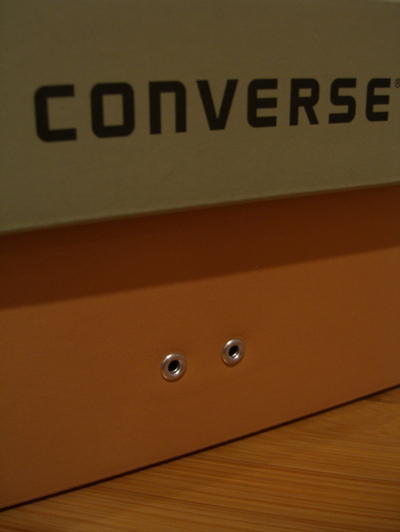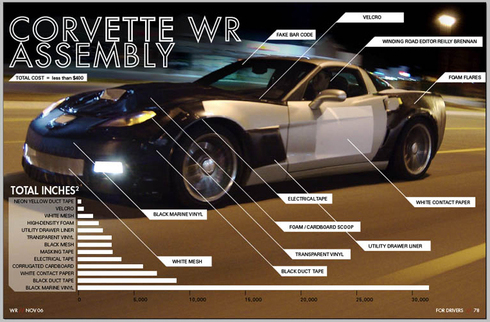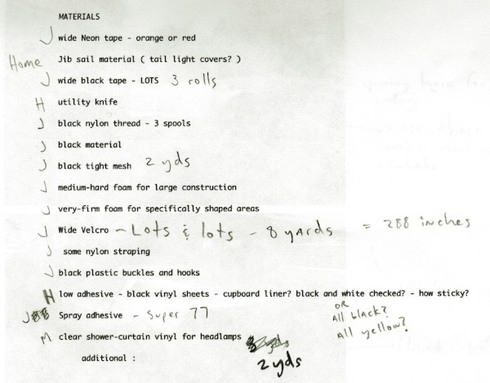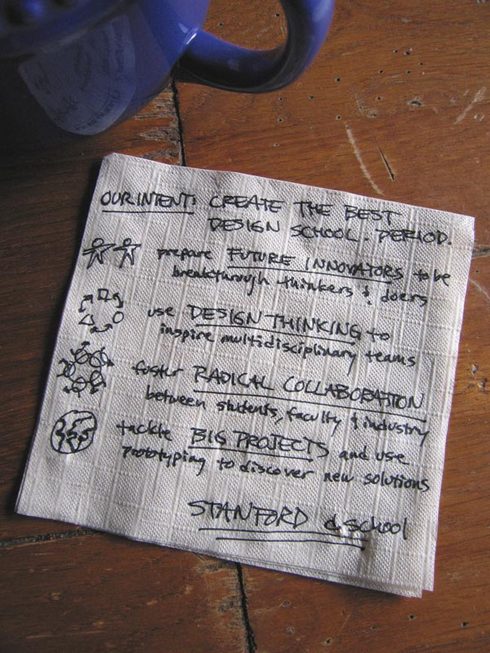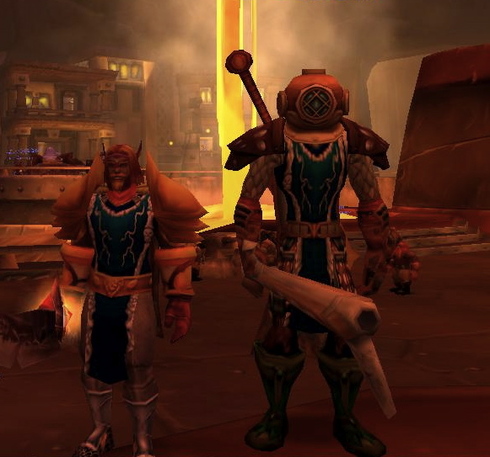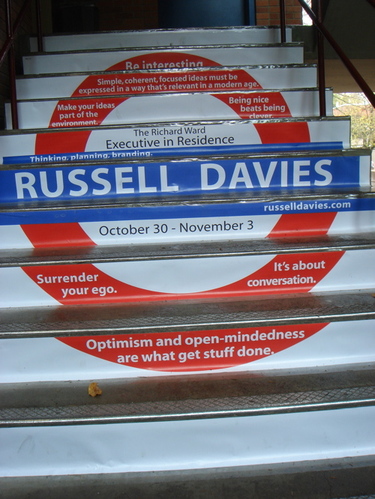"Our chefs and managers cook and run restaurants as if the word of mouth spread by each and every guest today will determine how full — or empty — our restaurants will be tomorrow. We work hard to hire people whose emotional skills — even more than how they can cook or serve wine — make them predisposed to deriving pleasure from the act of delivering pleasure. Long after our guests have forgotten how much they did or didn’t like the turbot or the lamb shank, they’ll remember how we made them feel."
– Danny Meyer, WSJ, 3Oct3006
Author Archives: Diego Rodriguez
Yes, we need some stinkin’ badges
I recently bought a pair of Jack Purcell shoes from Converse. A classic design, wouldn’t you agree?:
They’re good shoes. But what I really dug was the clever detailing on the box they came in:
My first reaction was something along the lines of "how clever!". What a nice way to echo the gestalt of the shoe in the shoe box. And then I thought, "how did the marketing manager for this line of shoes win the argument in favor of adding little metals shoe grommets to each and every box?" While grommets are cheap, they’re not free — a few cents here and there and it all adds up.
On the other hand, who says a brand logo needs can’t be a three-dimensional object, even on a lowly shoe box? Why not treat a logo more like a badge, as many automakers do? These Converse grommets are badges, and not so different than the nine (9!) brand badges which adorn my car (ten if you count the one on my key fob). Why print a swoosh or a set of mouse ears when you can a have a tangible brand expression?
Bravo, Jack Purcell!
Now that’s what I call infectious action (Part Deux)
What happens when people love your brand and what it could be so much that they’re willing to, err, mess with reality in order to make it so?
As detailed here (and in the diagram and Home Depot shopping list above) my pal Reilly Brennan of Winding Road went through a lot of trouble to create a "fake" version of the mysterious — and as of today, not on the market — Corvette Blue Devil. If you’re not a gnarly gearhead, a little background for you: people who love the Corvette are extremely interested in what’s next. What will Chevy do to make the next version that much better? Or will they screw it up? How might it allow them to go out and stomp on witless 911 and Viper owners? Or to win Le Mans yet again? It’s a community which is not only ripe for the spreading idea viruses, it’s one which welcomes them. And as Reilly has shown, Corvette aficionados want stories and myths that feed the story of why they bought their own car so much that they’ll believe anything. Because they want to. Describing this worldview, Reilly writes:
We have visions of high American optimism coupled with the fear of a regulated, sedan-like tomorrow. We dream of a world full of nightmarish Corvettes, those that rumble and break pavement and write "Zora" on blacktop when they leave stoplights.
In brief, Reilly and team took a stock Z06 Vette and mocked up their ersatz Blue Devil with a few hundred bucks of foam and vinyl and tape. They paraded it around Detroit, and some competing automotive journals even took the bait and published "spy" photos of their fake in action. Which is a fun outcome, but more significantly, rank-and-file citizens like and you and me were shouting "build it" when they saw the fake Blue Devil rumble by. Now, if you were Chevy, once you get beyond the act of outsiders pretending to be you, you’ve got to be happy with that outcome. Why? Because Winding Road’s Blue Devil is simultaneously an example of and a catalyst of the kind of user-generated brand content which Chevy tried to get with its much-discussed user-generated launch campaign for its Tahoe brand. Except, I’d argue, it represents an undeniably positive outcome from a brand point of view.
Philosophically, when it comes to creating infectious action, I see the fake Blue Devil as the same kind of expression as the user-generated Firefox cropcircle. They share some common elements and operate on similar principles:
- No permission asked (or required): I’m not sure how Reilly got the Z06 to modify in the first place, but I’d bet the MSRP of a Blue Devil that he didn’t detail out his aesthetic vision in detail to its owner. Put another way, I doubt GM would have sanctioned it. And the people at Firefox structure their marketing efforts in such a way that they don’t have to be consulted on every user-generated marketing action — a simple set of guidelines and community-based discussion forums is all it takes.
- It’s authentic: If GM had tried this as a publicity stunt, I wouldn’t be telling you about it. Yes it’s a fake car in a sense, but it’s a very real and authentic expression of brand love because of the folks behind it. Who blows 50-odd hours taping foam to a Corvette? What kind of group of people stomp out computerized patterns in a cornfield? Total weirdos who love you, that’s who. Weirdos = Authentic.
- It’s audaciously unexpected: Mess with an expensive, brand-new Corvette to create infectious action? Create a cropcircle of a software logo and then take an aerial photo (how did they do that, anyhow?). I don’t know about you, but I found both of these to be unexpected actions. And because of that, they’re easy to weave a yarn about, and they’re memorable. So, as evidenced by the high amount of web traffic I get linking back to the Firefox cropcircle post on this blog, they’re memorable stories that people want to pass along, infectiously.
- There exists a Dark side to The Force: As experienced by Chevy with its Tahoe campaign, letting people outside of your payroll create your marketing messages can be dangerous. People may call you nasty names and say bad things about you. The Firefox crop circle could just as easily have been a "Firefox Sux, Buy IE" slogan. And embedded in the fake Blue Devil mockup is a bit of a naughty streak, like something the fraternity in Animal House might have done. It’s funny, but does leave one feeling a little dirty. There’s a Dark Side, and one has to be mindful of it. In the end, the actions created by endeavors designed to be infectious can be deeply negative in the extreme, or else we wouldn’t be a species still engaged in genocidal activity. From a design point of view — designing the offering, designing the story, and designing the system to spread the story — the operating principles are the same.
Well, somehow I’ve managed to start with Corvettes and end with genocide. I didn’t expect to get there, but this is a long post, so I’ll stop here.
I’d love to hear what you think.
Belly Tanker Beausage
I love this photo detail from Bobby Greene’s "Aircraft latches and you" post from his wonderful blog Automotive Addictions and General Tomfoolery. It’s a blog about his very gnarly belly tanker speed racer. It’s an ode to gearhead gnarlyness, authenticity, and just plain doing stuff. I love it.
I also dig the photo because it’s a great example of beausage, the beauty which comes with use. All those scratches, dents, and subtle surface deformations couldn’t be designed. They come from being out in the world, and they’re beautiful in a very organic way.
Congratulations to Bobby for getting the tanker up and running — and running WFO, no less! — again.
Cool.
New! d.school news
We’ve just launched a news blog for the Hasso Plattner Institute of Design at Stanford (also known as the d.school).
This will be a space for us to talk about news and happenings in and around the d.school and the world of design thinking.
Each Spring Matters
John Maeda: Each Spring Matters
A beautiful piece of writing.
Watch disruption as it takes shape
Check out this update on The Venice Project, which promises to be to the traditional business models behind television as Skype is to your local phone company.
A press conference in Goldshire you shouldn’t miss
That’s me and my friend Ross hanging out in IronForge. It’s a great place to have a meeting and get some work done. Perhaps even do something innovative. In case you’re wondering, that’s me on the right — I’m the taller one sporting the diving helmet (which I engineered and fabricated myself, natch) and the longish gun, which was a gift. My trusted pet attack bear, Yogi, isn’t in the photo because just a few seconds earlier he wandered off in search of some cheese to eat and fell into a pit of lava.
But I digress.
Come December 1, Ross and his company Socialtext will be holding a press conference. What makes this one special is that it will be held in World of Warcraft in the charming village of Goldshire at the blood-soaked Gurubashi Arena. The whole event should be interesting, and if you’re a journalist or a blogger or someone interested in wikis and social software, you outta be there.
If none of this makes any sense to you, I’d encourage you to try out World of Warcraft and attend. I’ll even volunteer to walk you over from the city of Stormwind to the press conference location (or have Ross summon you there). I think all of these "games" such as World of Warcraft and Second Life are but the tip of the tip of the tip of the iceberg when it comes to understanding what our lives will be like in 10, 20, 30 years. And the best way to begin to understand is to jump in and wallow around. Learn by doing.
Find press conference details and signup instructions here on Joi Ito’s Socialtext Workspace
metacool Thought of the Day
Words of design thinking wisdom from Russell Davies


